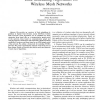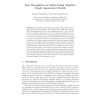COMSUR
2011
13 years 5 months ago
2011
Abstract—We provide an overview of link scheduling algorithms in Spatial Time Division Access (STDMA) wireless mesh networks. These algorithms can be classified into three categ...
ISVC
2010
Springer
14 years 4 months ago
2010
Springer
Abstract. In this paper, we present a novel graph, sub-graph and supergraph based face representation which captures the facial shape changes and deformations caused due to pose ch...
TKDE
2002
14 years 5 months ago
2002
In this paper, we have developed a HiTi (Hierarchical MulTi) graph model for structuring large topographical road maps to the minimum cost route computation. The HiTi graph model p...
ICIP
2002
IEEE
14 years 11 months ago
2002
IEEE
Many traditional relevance feedback approaches for CBIR can only achieve limited short-term performance improvement without benefiting long-term performance. To remedy this limita...
WAW
2007
Springer
15 years 2 days ago
2007
Springer
Inspired by the recent interest in combining geometry with random graph models, we explore in this paper two generalizations of the random dot product graph model proposed by Kraet...
WAW
2007
Springer
15 years 2 days ago
2007
Springer
The geographical threshold graph model is a random graph model with nodes distributed in a Euclidean space and edges assigned through a function of distance and node weights. We st...
SOFSEM
2007
Springer
15 years 3 days ago
2007
Springer
Digital technology is increasingly deployed in safety-critical situations. This calls for systematic design and verification methodologies that can cope with three major sources o...
LSSC
2007
Springer
15 years 3 days ago
2007
Springer
Abstract. Multiple sequence alignment is a key process in today’s biology, and finding a relevant alignment of several sequences is much more challenging than just optimizing so...
CLEF
2007
Springer
15 years 5 days ago
2007
Springer
This paper presents the LIG contribution to the CLEF 2007 medical retrieval task (i.e. ImageCLEFmed). The main idea in this paper is to incorporate medical knowledge in the langua...
HICSS
2009
IEEE
15 years 24 days ago
2009
IEEE
This paper discusses the design and implementation of a Service Generator Toolkit (SGT) that allows web services researchers to easily create large numbers of web services. When d...






